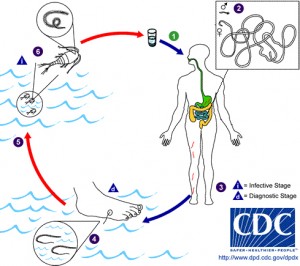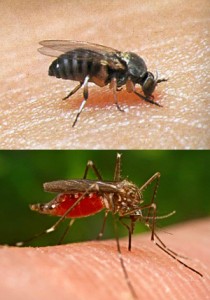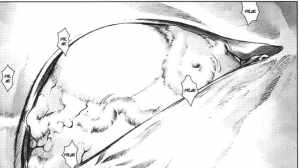13 Days of Halloween with The Owl in the Rafters: Day 10

 It’s already day 10 and we’re nearing the end, but today we have reached one of my personal favorites in the list, Manhole! I called Bio-Meat a proper zombie story done without zombies for tapping into the best elements of swarm horror and giving it a fresh interesting new skin, but this next story is a zombie story done unlike the typical zombie story. No swarms, no flesh eating, no undead. Instead it taps into some of the natural gore and horror elements of creatures living in nature, Manhole paints a brilliant image of a zombie outbreak grounded in real world concepts that isolates and stretches the viral element of zombie horror to its utmost limits.
It’s already day 10 and we’re nearing the end, but today we have reached one of my personal favorites in the list, Manhole! I called Bio-Meat a proper zombie story done without zombies for tapping into the best elements of swarm horror and giving it a fresh interesting new skin, but this next story is a zombie story done unlike the typical zombie story. No swarms, no flesh eating, no undead. Instead it taps into some of the natural gore and horror elements of creatures living in nature, Manhole paints a brilliant image of a zombie outbreak grounded in real world concepts that isolates and stretches the viral element of zombie horror to its utmost limits.
Before we get right into the manga itself, let me first take you aside and give a little briefing on the life cycle and behavior of an animal called the Dracunculus medinensis; more commonly known as the Guinea Worm. Many of you are probably a little too young to remember when this was a big public issue, but during the 1980s, following the end of his presidency in ’81, U.S. President Jimmy Carter and his wife founded the Carter Center and through it began a large public campaign to eradicate the global epidemic. In the 30 years since international medical relief services lead by the Carter Center have managed to par down the victim count by the hundreds of thousands annually. At the rate the they continue to work, you all may see within your lifetime the second time in recorded history that mankind has totally eliminated a disease. (The first was smallpox, in case you were wondering)
Anyhow, putting aside all the hope and humanitarian heroics, let’s get to the “good” stuff, shall we? Before the Carter Center helped put them on the decline, the D.medinensis was a species of parasitic roundworm that thrived all across Asia, Africa, and South America. The worms life cycle begins when their eggs are released into their freshwater habitat by a fertile mother.  The tiny eggs are then eaten by copepods (a species of tiny crustacean) commonly known as water fleas. The infected water fleas are virtually impossible to spot and identify with the naked eye. For this reason they are easily ingested by humans who go to unfiltered water sources on a regular basis for fresh water. Once the water flea host dies in the human stomach and the D.medinensis larvae is free to move about, it burrows into and through the stomach wall of the new human host. The worm then matures while digging through the human body and can grow to length of up to nearly 3 feet long. When the female worm burrows its way into the subcutaneous tissue (that is the bottom most level of your skin, where your blood and lymph vessels are and just above your outer most layer of muscle fiber.) she causes an allergic reaction in the skin that causes a blister to form. This blister induces agonizing pain that patients have likened to the feeling of hot coals being pressed and held against the skin. This burning sensation prompts the victim to douse the blistered area in water… where the now fertile female burrows through the skin, and escapes into the water to breed and infect a new body of water.
The tiny eggs are then eaten by copepods (a species of tiny crustacean) commonly known as water fleas. The infected water fleas are virtually impossible to spot and identify with the naked eye. For this reason they are easily ingested by humans who go to unfiltered water sources on a regular basis for fresh water. Once the water flea host dies in the human stomach and the D.medinensis larvae is free to move about, it burrows into and through the stomach wall of the new human host. The worm then matures while digging through the human body and can grow to length of up to nearly 3 feet long. When the female worm burrows its way into the subcutaneous tissue (that is the bottom most level of your skin, where your blood and lymph vessels are and just above your outer most layer of muscle fiber.) she causes an allergic reaction in the skin that causes a blister to form. This blister induces agonizing pain that patients have likened to the feeling of hot coals being pressed and held against the skin. This burning sensation prompts the victim to douse the blistered area in water… where the now fertile female burrows through the skin, and escapes into the water to breed and infect a new body of water.
 Oh, I’m not done yet! This disease spread via members of the phylum Nematoda is specifically called Filariasis and the Guinea Worm isn’t the sole perpetrator. Other filarial worms include the Onochocera volvulus which incubates in black flies, infects human via the black flies’ blood meal, and causes painful inflammation of the eye’s cornea and when untreated leads to eventual blindness, and the Loa loa which incubates in certain species of horseflies, which then bite and infect humans where they migrate throughout the body under the skin, causing painful irritations wherever they go, joint pains, and fatigue. (Their habit of traveling into and through the eye, causing swelling of the eyeball, has earned them the common name Eye Worm.) Filarial worms are also the cause of the elephantiasis disease, which is spread by mosquitoes. Other filarial worms with non-human mammal hosts are known to incubate various different species of flies, making their larvae much more mobile and their breeding grounds widespread.
Oh, I’m not done yet! This disease spread via members of the phylum Nematoda is specifically called Filariasis and the Guinea Worm isn’t the sole perpetrator. Other filarial worms include the Onochocera volvulus which incubates in black flies, infects human via the black flies’ blood meal, and causes painful inflammation of the eye’s cornea and when untreated leads to eventual blindness, and the Loa loa which incubates in certain species of horseflies, which then bite and infect humans where they migrate throughout the body under the skin, causing painful irritations wherever they go, joint pains, and fatigue. (Their habit of traveling into and through the eye, causing swelling of the eyeball, has earned them the common name Eye Worm.) Filarial worms are also the cause of the elephantiasis disease, which is spread by mosquitoes. Other filarial worms with non-human mammal hosts are known to incubate various different species of flies, making their larvae much more mobile and their breeding grounds widespread.
 There is also an entirely different phylum of worm called Nematomorphs, which (as the name suggests) strongly resemble Nematodes, and can be nearly indistinguishable in some cases. The Nematomorphs are known to infect arthropods like insects and crustaceans and then actually migrate to the host’s brain and alter the host’s behavior to better facilitate the worm’s breeding process. To be specific, one species is known to infect crickets and when ready to breed, will seize control of the cricket’s brain and cause it to seek out a body of water where the worm can breed, the cricket can’t swim of course so it drowns while the parasite escapes the body into the water.
There is also an entirely different phylum of worm called Nematomorphs, which (as the name suggests) strongly resemble Nematodes, and can be nearly indistinguishable in some cases. The Nematomorphs are known to infect arthropods like insects and crustaceans and then actually migrate to the host’s brain and alter the host’s behavior to better facilitate the worm’s breeding process. To be specific, one species is known to infect crickets and when ready to breed, will seize control of the cricket’s brain and cause it to seek out a body of water where the worm can breed, the cricket can’t swim of course so it drowns while the parasite escapes the body into the water.
Let me emphasize the key point here: They can control their host’s brains. Not just hijack it and feed it suggestions, mind you. They make their host willfully, and without hesitation, kill themselves. Keeping in mind that at the size of an insect, an animal’s brain is almost entirely built upon survival instinct. That means no sentient thought, no lust, no greed, no pride, no envy, no laziness, not even gluttony. They are driven entirely by the will to survive and live, and yet this parasite can override all of that.
 Similar tendencies can be found in the Leucochloridium paradoxum, which infect the brains of snails, and as the name suggests, paradoxically drives them into high open spaces where birds can see them, against all survival instincts, and then infect their eye-stalks to create catterpillar-looking inflammations to attract the predatory birds. The birds eat the snail’s infected eye-stalk and the worms breed inside the bird’s stomach, being spread across forests in the bird’s droppings, and free to infect more of the snails that feed on said droppings. But the L.paradoxum are actually neither a Nematode nor a Nematomorph, it is a flatworm, like flukes and tape worms, the latter of which I’m sure you’re well aware infect human hosts. Schistosomiasis is another disease caused by flatworms, and considered to be one of the most socially debilitating diseases in the world.
Similar tendencies can be found in the Leucochloridium paradoxum, which infect the brains of snails, and as the name suggests, paradoxically drives them into high open spaces where birds can see them, against all survival instincts, and then infect their eye-stalks to create catterpillar-looking inflammations to attract the predatory birds. The birds eat the snail’s infected eye-stalk and the worms breed inside the bird’s stomach, being spread across forests in the bird’s droppings, and free to infect more of the snails that feed on said droppings. But the L.paradoxum are actually neither a Nematode nor a Nematomorph, it is a flatworm, like flukes and tape worms, the latter of which I’m sure you’re well aware infect human hosts. Schistosomiasis is another disease caused by flatworms, and considered to be one of the most socially debilitating diseases in the world.
I’ll stop with the parasitology tangent for now, and just leave you with the fact that there are approximately 16,000 species of parasitic Nematode, 326 species of Nematomorphs which are all parasitic, and 40,000 species of Platyhelminthes (flatworms) 3 of 4 subdivisions of which are also purely parasitic. Of course those numbers only account for the species that have been identified to date, with more than twice as many total species estimated when including estimates of undiscovered species.
Now, let us briefly review our basic theory of evolution, shall we? Any species of living being will undergo random variations and mutations over the course of regular continued reproduction. Any species will face struggles in survival from generation to generation. Given enough continued generations all impractical variations and/or mutations will die, leaving only those variants and/or mutants that are practically suited to survive to continue to reproduce. If a surviving variation or mutation breeds with the common populace, that same variation or mutation will have a chance of naturally occurring throughout that continued bloodline. In other words if one conveniently well suited variation or mutation can outlive the originals, then the population of variations or mutations will eventually become comparable to the original population. And if a new threat arises that happens to favor one variation over the original species, then the ill suited branch of the species will diminish or die off while the better adapted survive. This is just how evolution works.
Okay, so maybe you’re wondering what on Earth I’m trying to get at with all this. Well, let me just lay the pieces out on the table. We have worms that infect people and use them as carriers for breeding. We have worms that manipulate and control the habits of their hosts directly from the brain. We have worms that can infect the human body, and even brain. We also have worms that spread through mosquitoes’ blood meals. So, given a few million generations (which would only take maybe a thousand years given their reproduction rates) what’s to say that a filarial worm capable of infecting and manipulating the human brain to facilitate its own breeding isn’t possible? Yes, what I’m talking about here is the basis of biologically feasible and statistically possible zombies.
 But let’s just get to the story, already! One day, in broad daylight a man describable only as “zombie-like” crawls out of a sewer manhole and into the middle of a busy Tokyo street. He wanders the streets and the sounds of busy crowds of shoppers dims to a distressed murmur. The “zombie” spots a particular young man on the street and suddenly his sights are focused. The “zombie” closes in on the unsuspecting man, and laying a hand on him causes the man to panic. One vomit of blood and a very freaked out shove later and the “zombie” is lying on the ground, dead. A strangely anticlimactic end to the zombie menace, or so it seems.
But let’s just get to the story, already! One day, in broad daylight a man describable only as “zombie-like” crawls out of a sewer manhole and into the middle of a busy Tokyo street. He wanders the streets and the sounds of busy crowds of shoppers dims to a distressed murmur. The “zombie” spots a particular young man on the street and suddenly his sights are focused. The “zombie” closes in on the unsuspecting man, and laying a hand on him causes the man to panic. One vomit of blood and a very freaked out shove later and the “zombie” is lying on the ground, dead. A strangely anticlimactic end to the zombie menace, or so it seems.
 During the autopsy, one of the “zombie” man’s eyes shoots open in reaction to an operating light, and suddenly, a worm begins to work its way out of the eyeball, trying to escape. The detectives get to work tracking down the identity of the “zombie” man while the medical team quickly realizes that the heath team needs to be called in and serious biohazard measures need to be taken while handling this case. Meanwhile the man who came in contact with, and technically killed the “zombie” finds himself fatigued, absent minded, and struggling to hold on to the most simplistic of thoughts.
During the autopsy, one of the “zombie” man’s eyes shoots open in reaction to an operating light, and suddenly, a worm begins to work its way out of the eyeball, trying to escape. The detectives get to work tracking down the identity of the “zombie” man while the medical team quickly realizes that the heath team needs to be called in and serious biohazard measures need to be taken while handling this case. Meanwhile the man who came in contact with, and technically killed the “zombie” finds himself fatigued, absent minded, and struggling to hold on to the most simplistic of thoughts.
 The case moves along slowly at first as Detective Mizoguchi Ken and Inoue Nao of the Sasahara precinct try to carry out a routine investigation of the “zombie” but it isn’t long before the case goes spiraling out of control and the detectives find themselves constantly just one step, and one second too late in stopping the horrifying epidemic that could reduce all of Tokyo to one giant groaning, moaning, shambling, brain-dead horde. Of course, there are plenty of twists and when it really counts every possible thing that could go wrong goes wrong. To top it all off, there are clues suggesting that the entire outbreak may be the work of some sort of mastermind and not a simple unfortunate coincidence, but what sort of madman would unleash this parasite menace onto the civilized world, and why? When the source of the outbreak is eventually found and confronted, the supposed mastermind’s true identity leads to a genuinely bone chilling sort of paradox of morality.
The case moves along slowly at first as Detective Mizoguchi Ken and Inoue Nao of the Sasahara precinct try to carry out a routine investigation of the “zombie” but it isn’t long before the case goes spiraling out of control and the detectives find themselves constantly just one step, and one second too late in stopping the horrifying epidemic that could reduce all of Tokyo to one giant groaning, moaning, shambling, brain-dead horde. Of course, there are plenty of twists and when it really counts every possible thing that could go wrong goes wrong. To top it all off, there are clues suggesting that the entire outbreak may be the work of some sort of mastermind and not a simple unfortunate coincidence, but what sort of madman would unleash this parasite menace onto the civilized world, and why? When the source of the outbreak is eventually found and confronted, the supposed mastermind’s true identity leads to a genuinely bone chilling sort of paradox of morality.
Manhole was both written and illustrated by Tsutsui Tetsuya, the author of other horror suspense and thriller series such as, Duds Hunt – The Network Survival Game, Reset, Collector, and just recently a new title called Yokokuhan. Tsutsui Tetsuya has displayed over the past ten years of his career, a great flare for suspense and drama, and Manhole is no exception.

The story follows certain popular trends in zombie fiction and interprets them in the most practical ways possible. Certain little cliches turn out to be just as true in Manhole as in other zombie stories, while others get tossed entirely to the wayside or turned on their heads. Impressively written, well conceived, and well researched, the whole thing runs a total of just 29 chapters, totaling 3 volumes, and could probably have made one hell of a movie. In fact, the final chapter of the manga even has credits worked into panels like actual film credits.
There have been no signs of an English release, but French publishing company Editions Ki-oon jumped on it almost immediately, followed by Edizioni BD s.r.l. licensing the title in Italy, and Sharp Point Press in China. All three of companies have also published Tetsuya’s Duds Hunt and Reset as well, neither of which have seen English translation or shelf life. (Seriously America, get on the ball! Even Poland got their hands on a license of Duds Hunt already.) I should also point out that aside from some blood, gore, and disease related body horror that won’t sit well with the squeamish types, there is also some mild nudity and sexual themes that ought to be cautioned against. Apart from that little warning however this is a title I highly recommend if not insist that you track down and read if you are any sort of fan of horror.

















iStalk? uStalk!